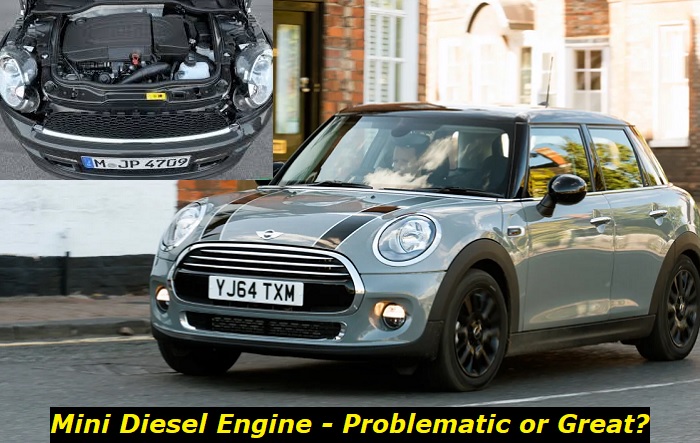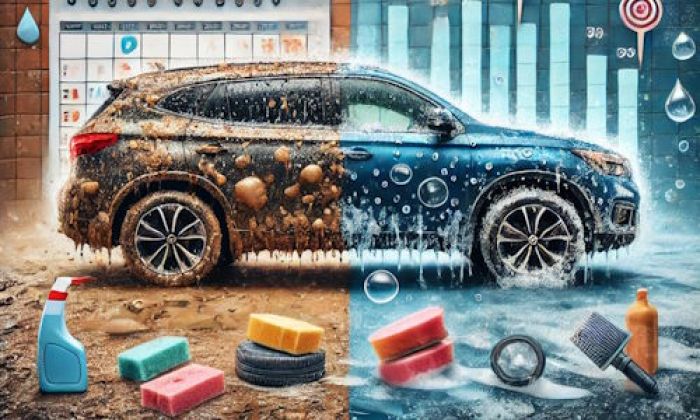The Mini diesel engine has evolved over the years. It was initially sourced from Toyota and Peugeot until BMW took over the helm of its development. Along with its transition were its ups and downs.
In general, the Mini diesel engine has received mixed feedback from owners over the years due to some problems that are known to crop up as it rakes in significant mileage. On the other side of the fence, some users have praised it for its high level of fuel economy and reliability. So, in this article, we will weigh in on the matter by revealing to you its most common problems and by looking at its key selling points.

Most Common Problems of the Mini Diesel Engine
Just like any other engine, the Mini diesel units have their flaws. Among the most common results of these are the following:
1. Check Engine Light On
The Check Engine light is a pretty common occurrence in aging cars, especially if they are already past due their maintenance schedules or there are parts that need replacement. However, this can sometimes be tricky to diagnose because it can be triggered by either or both mechanical or electrical issues in your vehicle. When it comes to a Mini diesel engine, the Check Engine light can be caused by several different issues.
The most common causes of this problem in a Mini diesel engine are due to low fuel quality, worn-out spark plugs, faulty EGR valves, erring sensors, or clogged fuel filters. To evaluate the root of the problem, you should first look for any symptoms that may point to an underlying issue such as increased exhaust smoke, misfiring engines, or stalling while idling.
You should then take a visual check under the hood and inspect all components like air filter housings and hoses for signs of wear or damage. Finally, use tools such as an OBD-II scanner or multimeter to diagnose any electrical problems with your car.
The solution for this problem will vary depending on the cause, but in many cases, it simply requires replacing or servicing the affected parts. This may include spark plugs, fuel filters, EGR valves, and other components associated with emissions control.
In some cases, you may need to retune your engine for better performance or replace a faulty ECU (Engine Control Unit) or sensors. If nothing else works, you could always take your car to a professional mechanic who can get to the bottom of the issue faster than you would be able to yourself.
2. Oil Starvation
Many things can cause oil starvation in the Mini diesel engine but the most common is carbon build-up in the unit. This can be caused by a lack of maintenance over time, or if the engine has previously been run on contaminated oil.
To assess this issue, you should look for symptoms such as reduced performance and power output, increased fuel consumption, excessive smoke from the exhaust pipe during acceleration, changes in emission levels, and loud engine noises.
You can also do manual checks to further diagnose the problem. Checking the dipstick will help you determine if there is enough oil in the system and whether or not it is still in good quality. Simply replenish the oil if it is already low or have it flushed if it is contaminated.
You can also check under the bonnet to look out for any signs of leaking or burning oil near the intake manifold. Additionally, using an OBD-II scanner to see if there are any trouble codes related to low oil pressure will indicate whether or not it is an actual oil starvation issue.
If it is determined that oil starvation is the cause of the problem despite having adequate good-quality oil in your car's reservoir, then a few different parts may need to be replaced or repaired. The most likely culprits are the oil pump and its associated pick-up tube, which can get blocked or damaged over time due to carbon build-up.
Additionally, if the engine has been running on contaminated oil for a time already, you may need to replace the timing chain and sprockets as well as any related seals and gaskets. Lastly, replacing any worn-out fuel filters will also help ensure that no contaminants can potentially enter the system until your car's next scheduled servicing.
When dealing with an oil starvation issue in a Mini diesel engine it is important to assess the source of the problem and to replace any affected parts that may need it. Moreover, ensuring a regular maintenance schedule and making sure that only good quality oil is used in the system will also help prevent future issues from occurring.
3. Engine Mount Failure
An engine mount failure on a Mini diesel engine can cause significant damage to the power unit and surrounding components, resulting in major repair costs. The most common causes of this type of problem stem from wear and tear over time, damage due to impact or too much heat, or faulty installation during assembly.
Evaluating the root of the problem should begin by looking for symptoms such as too much vibration, excessive noise, oil leaks, engine misfires, or other performance issues. Visual inspection of the mounts is also critical in determining signs of damage or breakage which may be caused by movement between parts due to loose mounting bolts or fatigue from constant vibration.
Replacing the failed mount, as well as any related parts in the engine bay - such as hoses, gaskets, or other components that may have been affected by the failure - is the best solution to this type of problem. Other solutions such as reinforcing the existing mount with additional material or re-tightening bolts may be temporary fixes but should not be expected to provide a permanent remedy.
It is important to identify and properly diagnose engine mount failures on Mini diesel engines to ensure their safe operation and prevent further damage to their surrounding components.
4. Various Leaks
The Mini diesel engine is notorious for its leaky components after accumulating a significant amount of mileage. The parts that are prone to this are the water pumps, radiator, and electric power steering pump. It is important to note that the leaks can occur in any of these components or simultaneously, making it difficult to identify where the real source of the leak is coming from.
The first thing to do when trying to diagnose a leaky Mini diesel engine is to look for signs of fluids pooling beneath the vehicle. This could be a telltale sign of oil, coolant, or other fluids. Next, one should visually inspect all components mentioned above for wet spots that are indicative of leaking fluids. If no visible signs are present, then a specialized tool may be needed to detect and pinpoint the source of the leak.
To fix this issue, parts such as hoses, seals, gaskets, and O-rings may need replacing. It is important to double-check all components for wear and tear and make sure that the damage has not spread beyond the original leak source.
If other parts have been affected, then it is advisable to replace them as soon as possible to ensure that further damage does not occur in the future. Furthermore, one can also take preventative measures such as refilling fluids regularly and ensuring that they are at the proper levels to avoid lubrication problems from occurring down the road.
The Mini diesel engine needs a great deal of care to maintain its reliable performance over time. By understanding how leaks occur and taking steps to identify and repair them quickly, one can keep their vehicle functioning optimally down the road.
Is It Any Good?
According to automotive analysts and public consensus, the problems mentioned in the previous section tend to crop up in the used versions of the model produced sometime between the 2000s and 2013. So, instead of buying them, opt for the later versions of the diesel-powered Minis, particularly its third-generation models produced beginning in 2015.
For the most part, the third-gen Minis fitted with diesel engines such as the Mini One D, Cooper D, and Cooper SD are fun to drive. Through its different trims, the range caters to different kinds of drivers who either prefer more fuel economy or more performance from a compact car.
Drivers who are looking for the best fuel economy should opt for the Mini One D with an impressive rate of 83.1 mpg according to its maker. However, it may not be for everyone, especially those who are looking for more power in a compact car as it only produces 95 hp and 162 lb-ft of torque in its 1.5-liter engine translating to a sluggish 0 to 62 mph acceleration time of 11.6 seconds.
Those who are in for more power can go for the Mini Cooper SD with more displacement at 2.0 liters capable of 168 hp and 266 lb-ft of torque. At its best, it can sprint from 0 to 62 mph in 7.2 seconds, which is decent enough for such a classy compact car. The tradeoff, however, is a reduced fuel economy of 70.6 mph, which is still a very good number especially with the rising prices of diesel fuel nowadays.
For a balance of both, the Cooper D serves as an ideal compromise with its 114 hp and 199 lb-ft of torque coming from a 1.5-liter engine. Its setup lets it run from 0 to 62 mph in 9.2 seconds while its fuel economy is pegged at 80.7 mph.
Overall, the diesel engine in third-gen Minis can prove to be a reliable and economical power source for drivers who are looking for a pocket-friendly ride that offers good value. However, either due to age or lack of proper maintenance, it is important to stay vigilant and address the issues mentioned above as soon as they arise to ensure smooth operation in the long run. In this way, you can look forward to years of enjoyment with your Mini diesel car.
About the authors
The CarAraC research team is composed of seasoned auto mechanics and automotive industry professionals, including individuals with advanced degrees and certifications in their field. Our team members boast prestigious credentials, reflecting their extensive knowledge and skills. These qualifications include: IMI: Institute of the Motor Industry, ASE-Certified Master Automobile Technicians; Coventry University, Graduate of MA in Automotive Journalism; Politecnico di Torino, Italy, MS Automotive Engineering; Ss. Cyril and Methodius University in Skopje, Mechanical University in Skopje; TOC Automotive College; DHA Suffa University, Department of Mechanical Engineering






Add comment